brake light BUICK ROADMASTER 1993 Owners Manual
[x] Cancel search | Manufacturer: BUICK, Model Year: 1993, Model line: ROADMASTER, Model: BUICK ROADMASTER 1993Pages: 340, PDF Size: 18.34 MB
Page 14 of 340
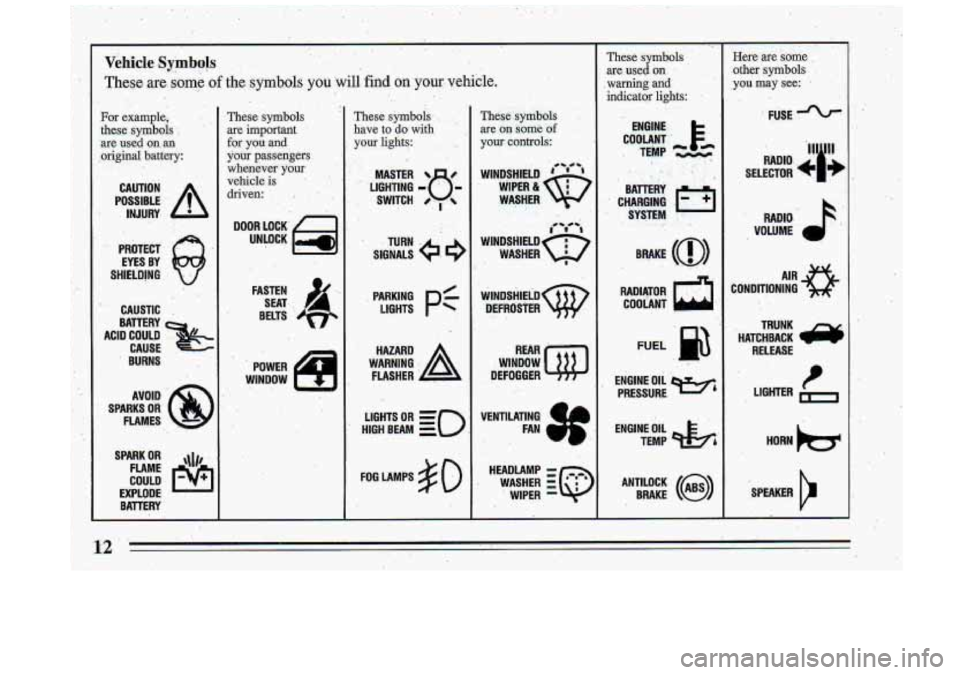
Vehicle Symbols . , . '
mcese are some .of the,symbols you will find on your vehicle. . ' . '".' . '*
I. .. . .- . .* . t . . :.
.. ... .. , I. .'
For example,
these symbols
'
are used on an
original battery:
CAUTION
INJURY
..
POSSIBLE: .' A
.' PR~TECT @
EYES BY
SHIELDING
CAUSTIC
ACID COULD
&
BATTERY CAUSE
BURNS
SPARKS AVOID
OR '"8
FLAMES
COULD
EXPLODE BATTERY
I,
These symbols
are
important
for you.and.
your passengers
whenever your
vehicle-is- ' .
driven: ~ , E , .. , .,
iI
..
DOOR LOCK,' f 1
UNLOCK e
SEAT,
BELTS
WlNDOW
f -1
POWER
These symbols, . _.
have to'do with , .
your lights: ' ,. , - .<
*_
' 'LIGHTING
-8-
MASTER %. . 8
. 'SWITCH /., .
PARKING pf
LIGHTS
HAZARD
WARNING
:A
FLASHER
HIGH
'IGHTS BEAM OR = =o
,. T.hese symbols ',
are on some bf
your controls.:
WIN'DSHIELD. ' ' ' 0- c,
WIPER a Q
WINDSHIELDQ WASHER
** ri I91
WASHER I
. WlNDSHlELD(fji)
DEFROSTER
,) .
WINDOW
DEFOGGER
' WASHER EG
HEADLAMP -
WIPER
These symbols
are used on '
,warning and
indicator lights:
RADIATOR COOLANT
FUEL
ENGINE OIL 'e,
PRESSURE
TEMP
Oli 4%
ANTILOCK. (a)
BRAKE
Bere are some
other symbols
,you may see:
FUSE
RADIO.
CONDITIONING ..
TRUNK
HATCHBACK
e
RELEASE --
LIGHTER e,
SPEAKER
b
?
Page 83 of 340
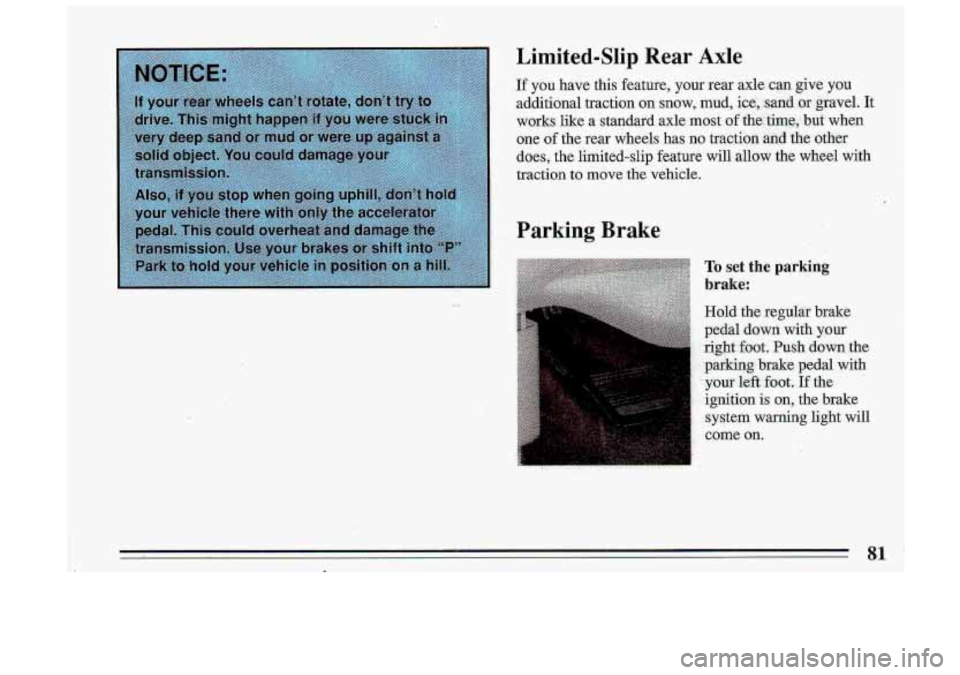
Limited-Slip Rear Axle
If you have this feature, your rear axle can give you
additional traction on snow,, mud, ice, sand or gravel. It
works like a standard axle most of the. time; but when
one of the rear wheels has
no traction and the other
does, the limited-slip feature will allow the wheel with
traction to move the vehicle.
Parking Brake
To set the parking
brake:
Hold the regulaT brake
pedal down- with y,our
rightfoot. Push down the
1: parkng. brake pedal with
1;. -your lefi-foot.. rf the
1:. 'ignition is on, the brake
i~ ,system warning light will
come
on.
Page 97 of 340
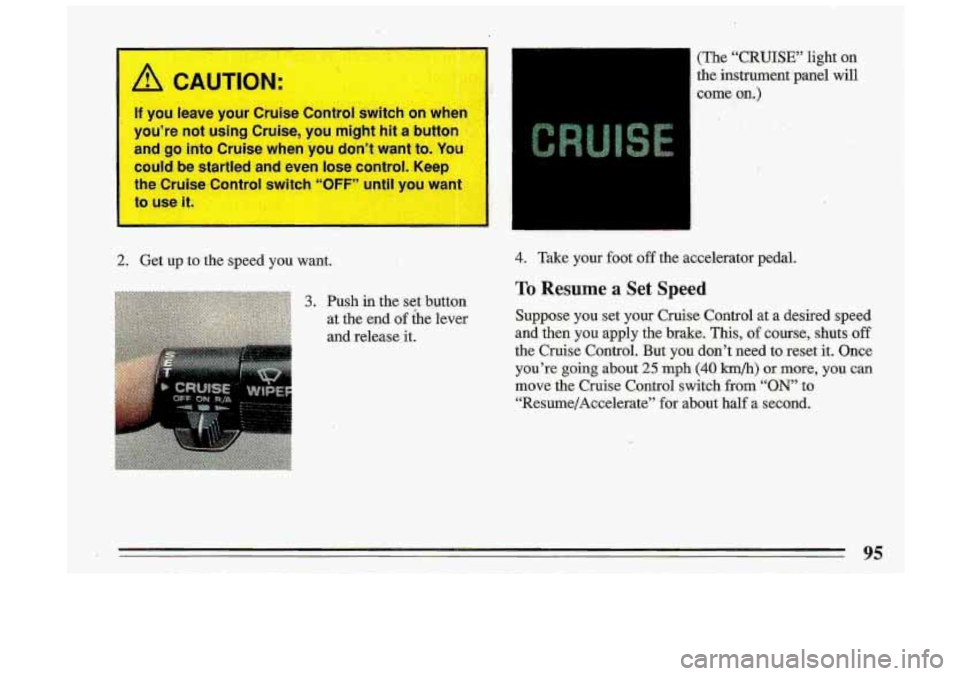
If you leave your Cruise Control si ch on when
you’re not using Cruise, you. might hit a button
and go into Cruise when you don’t want
to.. Yoe
could be startled and even lose control. Keel
I the Cruise Control switch “OFF’’ until you want
to use
it.
2. Get up to the speed you want.
3. Push in the set button
at the
end of ihe lever
and release
it.
(The “CRUISE’ light an
the instrument panel will
corne an.)
4. Take your foot off the. accelerator pedal.
To Resume a Set Speed
Suppose you set your Cruise Control at a desired speed
and then you apply the brake. This,
of course, shutsoff
the Cruise Control. But you don’t need to reset it. Once
you’re going- about 25 mph (40 h/h) or more, you can
move the Cruise Control switch from “ON’ to
“Resurne/Accelerate” for about half
a second.
95
Page 100 of 340
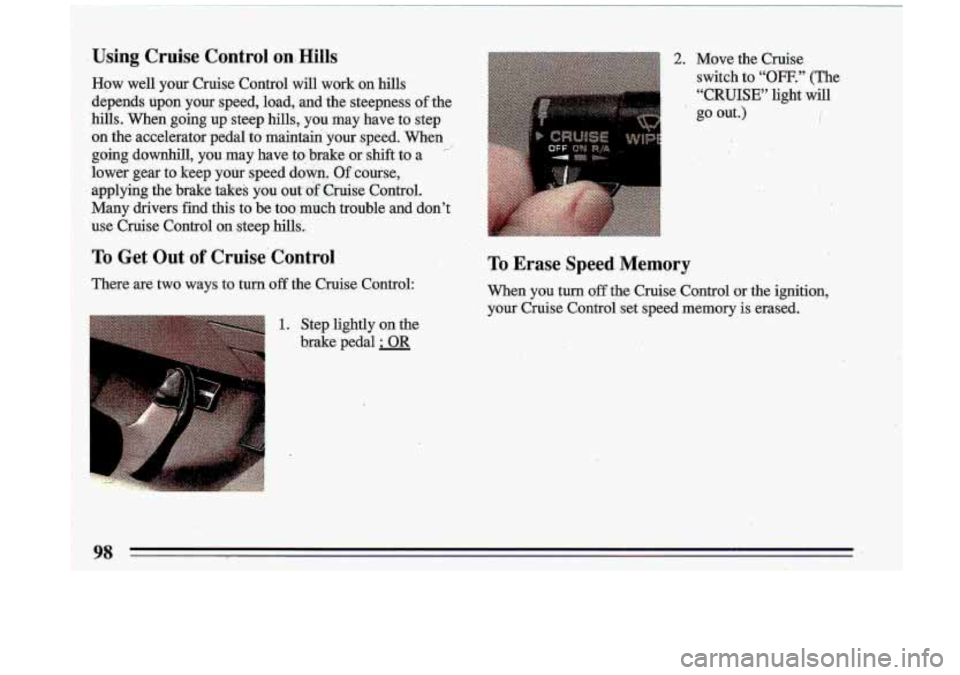
Using LruIse Control on Hills
How well your Cruise Control will work on hills
depends upon your speed, load, and the steepness ofthe
hills. When going up steep hills, you may have to step
on the accelerator pedal to maintain: your speed. When
going downhill, you
may have to brake or shift to a
lower gear to keep your speed duwn.
Of course,
applying the brake takes you out of Cruise Control.
Many drivers find this to be too much trouble and don't
use Cruise Control
on steep hills., , .
To Get Out of Cruise'Control
There are two ways to turn off the Cruise Control:
1. Step lightly on the
., .-..
1; ;', , ;;brake pedal ; OR
! it
E
To Erase Speed Memory
When you turn off the Cruise Control or the ignition,
your Cruise Control .set speed memory is erased.
Page 122 of 340
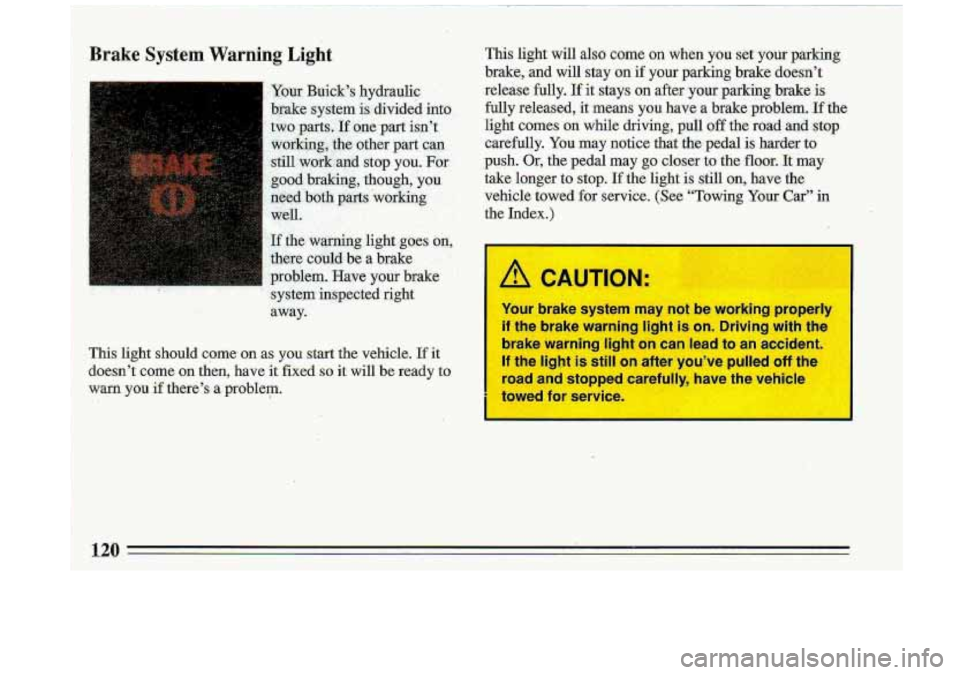
Brake System Warning Light
I Your Buick’s hydraulic .. . -
brake system is divided intd
two parts..If Qne-part isn’t
working, the other
part’ can
stil1,work:aT;lCl stop you. For
g,ood. braking, though, you.
need ‘both parts working,
.. ’.
well. - ’ . i; &. ..
If the. warning light goes an,
there -cbuld be a brake
.L_ ., . - , >.
problem. Have your brake ’
’ system inspected .. . right .. . ,
away.-
. . . , .I
This light should come’ on as you start the vehicle. If it
doesn’t corne on then, have it fixed
so it will be ready to
warn you
if there’s a problem.
This light will also come on when you set your parking
brake,
and will stay on if your parking brake doesn’t
release fully.
If it stays on after. your parking brake is
fully released,
it means you have a brake problem. If the
light comes on while driving, p.d off the- road and stop
carefully. You may notice that the pedal is harder
to
push. Or, the pedal may go closer to the floor. It may
take longer to stop.
If the light is still on, have the-
vehicle towed for service. (See “Towing Your Car” in
the Index.)
/! CAUTION.
Your brake system may not be working properly
if the brake warning light is on. Driving with the
brake warning light on can
lead to an accident.
If the light is still on after you’ve pulled off the
road and stopped carefully, have the vehicle
ta
?d for SE ice
Page 123 of 340
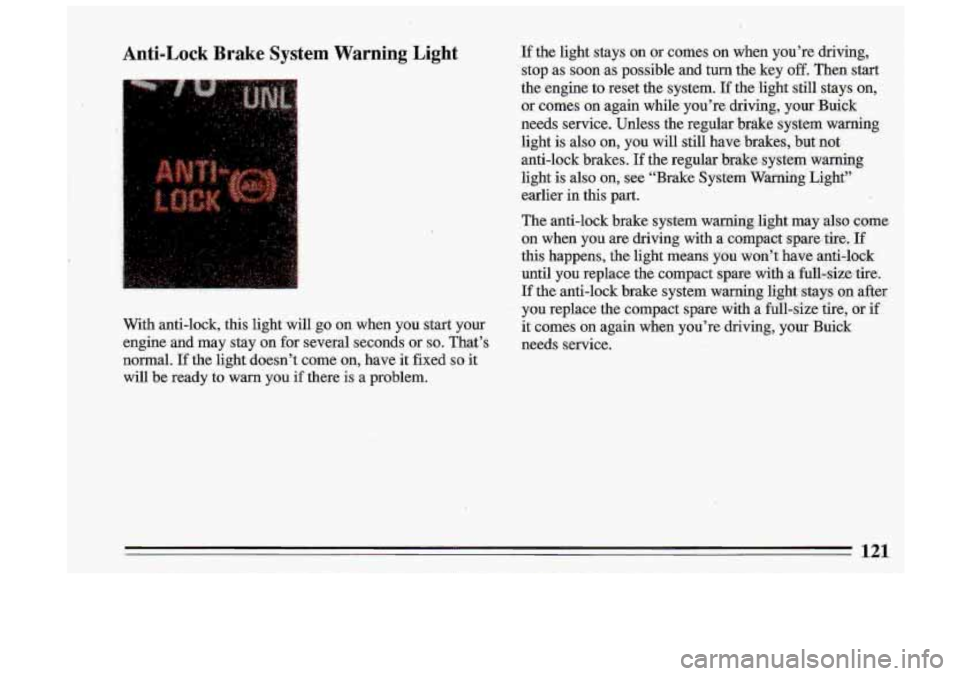
iI
Anti-Lock Brake System Warning Light
. -, i’
.. I. ,:,:
With anti-lock, this light will go on when you start your
engine and may stay on for several seconds or
so. That’s
normal.
If the light doesn’t come on, have it fixed so it
will be ready to warn you if there is a problem.
If the light stays on or comes on when you’re driving,
stop as soon as possible and turn the key
off. Then start
the engine to reset the system.
If the light still stays on,
or comes on again while you’re driving, your Buiek
needs service. Unless the regular ‘brake system warning
light is also
on, you will still have brakes, but not
anti-lock brakes.
If the regular brake system warning
light is also
on, see “Brake System Warning Light”
earlier
in this part.
The anti-lock brake system warning .light may also come
on when you are driving with
a compact spare. tire, If
this happens, the light means you won’t have anti-lo,ck
until you replace the compact spare ,with
.a fuU-simtire.
If the anti-lock brake system warning light stays
on after
you replace the compact spare with a full-size tire, or if
it comes
on again when you’re driving, your Buick
needs service.
121
Page 161 of 340
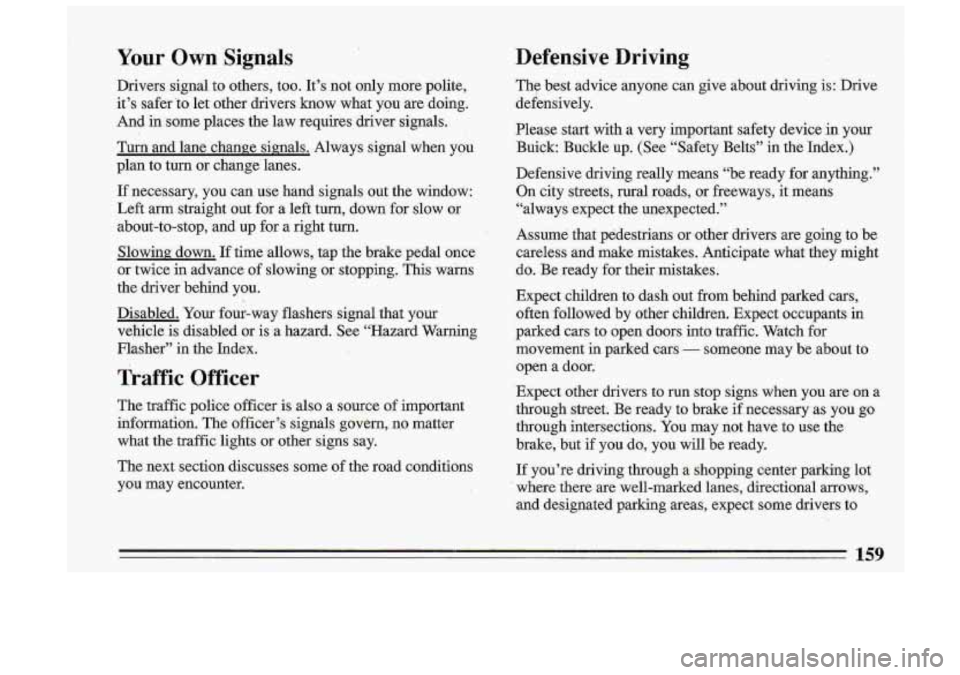
Your Own Signals Defensive Driving
Drivers signal
to others, too. It’s not only more polite,
it’s safer ‘to let other drivers know what you are doing.
And in some places the law requires driver signals.
Turn and lane change signals. Always signal when you
plan to turn or change lanes.
If necessary, you can
use hand signals out the window:
Left arm straight out for
a left turn, down- for slow or
about-to-stop, and up for a right turn.
Slowing. down. If time allows, tap the brake pedal once
or twice
in advance of slowing or stopping. This warns
the driver behind you.
Disabled. Your -four-way flashers signal that your
vehicle is disabled or is a hazard. See “Hazard Warning
Flasher” in the Index.
Traffic Officer
The traffic police officer is also a source of important
information.
The officer’s signals govern, no matter
what the traffic lights or other signs say.
The next section discusses some of the road conditions
you
may encounter. The
best advice anyone can give about driving is: Drive
i
defensively. !
Please start with a very important safety device in your
Buick: Buckle up. (See “Safety Belts” in the Index.) i
Defensive driving really means “be ready for anything.”
On city streets, rural roads, or freeways, it means
“always expect the unexpected.”
Assume that pedestrians or other drivers are going to be
careless and make mistakes. Anticipate what they might
do. Be ready for their mistakes.
Expect children to dash out from behind parked cas,
often-followed by other children. Expect occupants
in
parked cars to open doors into traffic., Watch for
movement
in parked cars - someone may be about to
open a door.
Expect other drivers to run stop signs when. you are on a
through street. Be ready to brake if necessary
as you go
through intersections. You may not have
to use the
brake, but if you do, you will be ready.
If you’re driving through a shopping center parking lot
where there are well-marked lanes, directional arrows,
and designated parking areas, expect.some drivers to
159
__
Page 166 of 340
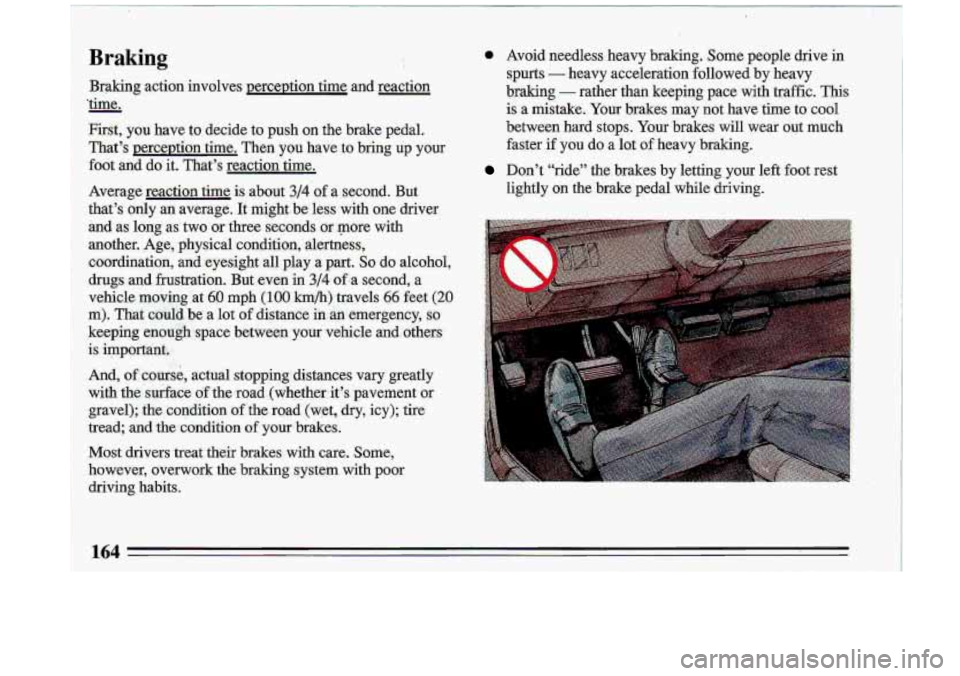
Braking
Braking action- involves perceDtion time and reaction
’time.
First, you have to decide to push on the brake pedal.
That’s perception time. Then -you have to bring
up your
foot and do it. That’s reaction-time.
-
Average reaction time is about 314 ‘of a second. But
that’s only -an average. It might be less with one driver
and as
long as two or.three seconds or .more with
another.
drugs and frustration. .But even in
3/4 0f.a second, a
vehicle moving at
60 mph (1 00 h/h) travels 66 feet: (20
m). That could. be a lot of distance in an-emergency, so
keeping enough- space between your vehicle and-others
is important.
And, of course, actual stopping distances vary greatly
with the saiface- of the raad.(whether it’s pavement or
gavel); the condition of the road (wFt, dry, icy); tire
tread; and
the condition of your brakes.
Most -drivers treat their brakes with care. Some,
however; overwork the braking system with poor
driving habits.
* Avoid needless heavy braking. Some people drive in spurts
- heavy acceleration followed by heavy
braking
- rather than keeping pace with traffic. This
is a mistake. Your brakes may not have time to cool
between hard stops. Your brakes will wear out much faster if you do a lat of heavy braking.
Don’t “ride” the brakes by letting your left foot rest
lightly on the brake pedal while driving.
Page 170 of 340
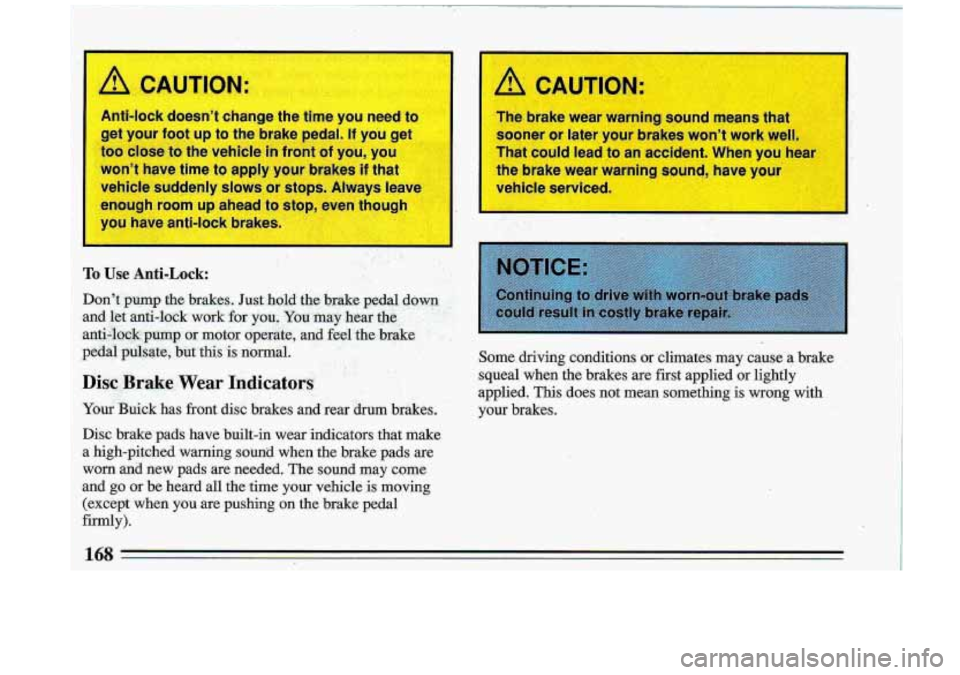
I
1 /! CAUTION: A CAUTION:
The brake wear warn g s
sooner or later your brakes won’t work well
That could lead
to an accident. When you hear
the brake wear warning
-- -3 your
vehicle serviced. -. --I - ,~
I
Some driving conditions or climates may cause a brake
squeal when the brakes are first applied or lightly
applied. This
does not mean something is wrong with
your brakes.
Page 172 of 340
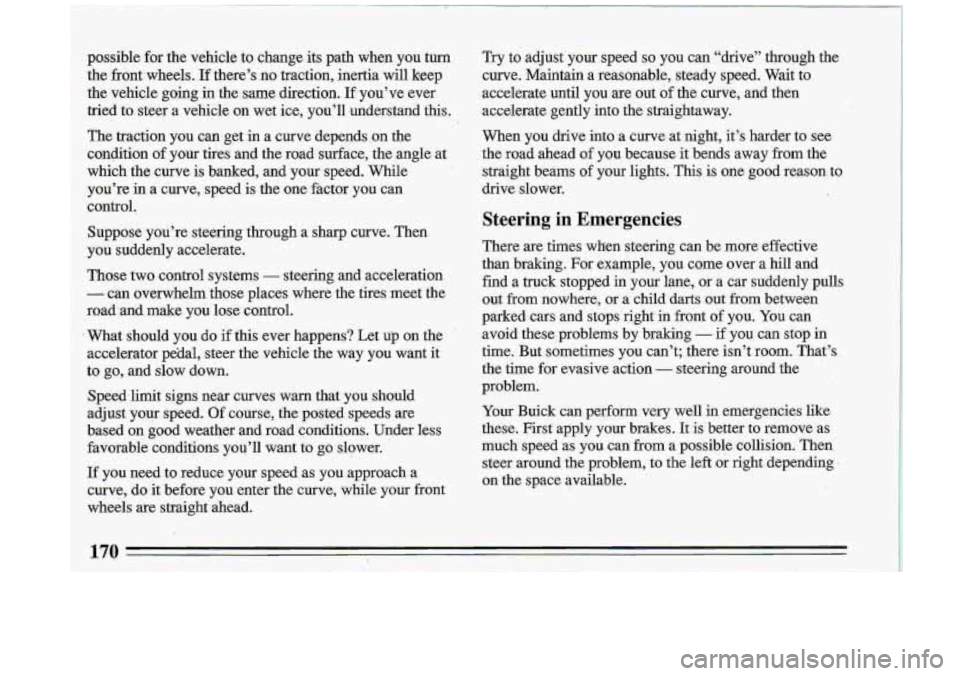
Try to adjust‘ your speed so you can “drive” through the
curve. Maintain a reasonable, steady speed. Wait to
accelerate until you are out
of the curve, and then
accelerate gently
into the straightaway.
When you drive into a curve at night, it’s harder to see
the road ahead
of you because it bends away from the
straight beams
of your lights. This is one good reason. to
drive slower.
Steering in Emergencies
There are times when steering can be more effective
than braking. For example, you come over a hill and
find a truck stopped
in your lane, or a car suddenly pulls
out
f-rom nowhere, or a child darts out from between
parked
cars and stops right in front of you. You can
avoid these problems by braking
- if you can stop in
time. But sometimes you can’t; there isn’t room. That’s\
the time for evasive action
- steering around the
problem.
Your Buick can perform very well in emergencies like
these. First apply your brakes. It is better to remove as
much speed as you can
from a possible collision. Then
steer around the problem, to the left
or right depending
on the space available,